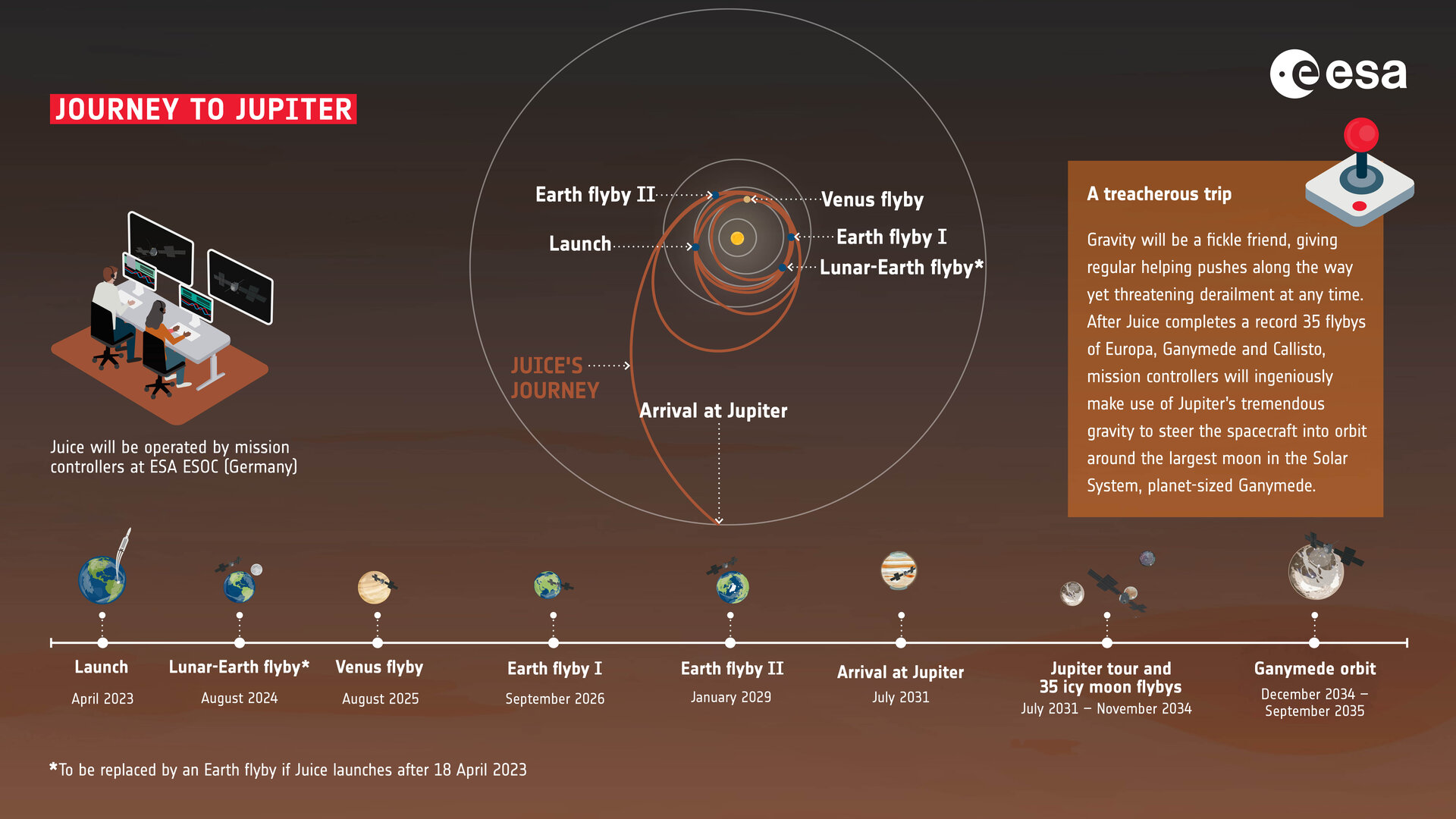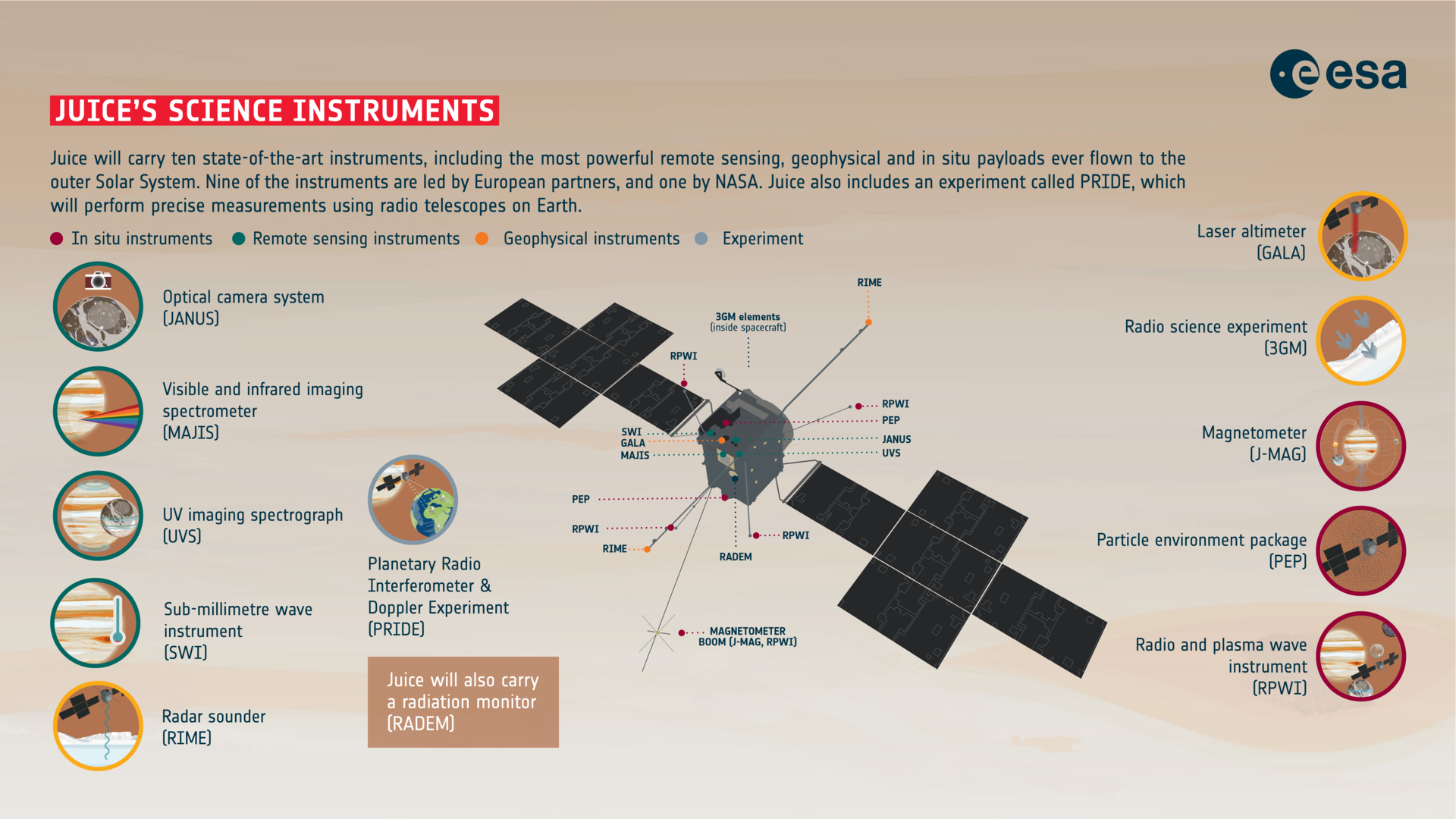User rating: 5 / 5
In April 2023, Europe will launch an unmanned space probe to closely examine Jupiter’s largest moon. Jupiter Icy Moons Explorer (JUICE) has been developed by the European Space Agency ESA and should reach the gas giant Jupiter in July 2031. After that, the space probe will closely study Jupiter’s moons Ganymede and Europa, among others, so that JUICE also becomes the first A space probe orbiting another planet’s moon.
More than 2,000 people from 23 countries
Jupiter Icy Moons Explorer (JUICE) is being built at the European aerospace company Airbus Defense and Space in Friedrichshafen and will weigh six tons at launch. The spacecraft is equipped with eleven scientific instruments including cameras, spectrometers, radars, and a magnetometer. Using these tools, scientists want to learn more about the hidden oceans on some of Jupiter’s moons, as well as study the composition of these moons in depth. In addition, they also want to study the magnetic fields of Ganymede and Jupiter to see how they interact. Thanks to the giant solar panels, the total area of which is 85 square meters, the spacecraft will be powered during its long journey to Jupiter and the study of Jupiter’s moons. Combined, these large solar panels generate 800 watts of power, despite the fact that sunlight at Jupiter is 25 times weaker than sunlight near Earth. To communicate with Earth, JUICE is equipped with a satellite dish with a diameter of 2.5 meters. The six-ton space probe is to be launched on April 13, 2023 from the European launch site in French Guiana using a powerful European Ariane V rocket. More than 2,000 people in 23 countries and from 18 scientific institutions and 83 companies have worked on the JUICE project in recent years . The US and Japanese space agencies have also provided hardware for the JUICE mission.
Scientific Instruments Overview
- Jovis, Amorum ac Natorum Undique Scrutator (JANUS)
- Jupiter and Moon Imaging Spectrometer (MAJIS)
- Ultraviolet Imaging Spectrometer (UVS)
- Sub millimeter wave instrument (SWI)
- Ganymede Laser Altimeter (GALA)
- Radar for Icy Moon Exploration (RIME)
- JUICE magnetometer (J-MAG)
- Particle Environment Package (PEP)
- Radio and Plasma Wave Inspection (RPWI)
- Gravity and Geophysics of Jupiter and its Galilean Moons (3GM)
- Planetary Radio Interferometer and Doppler Experiment (PRIDE)
Photo: ESA
Long trip to Jupiter
JUICE’s journey to Jupiter will take at least eight years. During this trip, the European space probe will make several flybys of Earth and Venus. In October 2029, JUICE will fly by asteroid 223 Rosa. Ultimately, JUICE should reach the gas giant Jupiter in July 2031, after which the spacecraft should make its maiden flyby of Jupiter’s moon Ganymede. A year later, in July 2032, JUICE will fly by Jupiter’s moon Europa for the first time, after which the spacecraft will examine Jupiter’s polar regions and magnetic field. While studying Jupiter’s moon Europa, scientists want to learn more about cracks in the moon’s frozen surface and strange geysers that spew water into space. In December 2034, JUICE should finally orbit the moon Ganymede and then fly by in 2035 just 500 kilometers above the surface of Ganymede. This will be the first time a spacecraft has been in a stable orbit around another planet’s moon. While in orbit around Ganymede, JUICE will examine the composition and magnetic field of Jupiter’s largest moon. Ganymede has a diameter of 5,268 km and is the only planetary moon with a magnetic field. Like Jupiter’s smaller moon Europa, Ganymede has a deep subsurface ocean that may have supported primitive life. The many planned flybys of Jupiter and its moons are not without risks as radiation can damage spacecraft instruments and the massive gravity of Jupiter’s giant planet can disrupt JUICE’s flight path.

MAJIS: Belgian contribution to JUICE
MAJIS (Jupiter and Moon Imaging Spectrometer) is an instrument aboard JUICE and is a visible and infrared imaging spectrometer, operating from 400 nm to 5.70 µm, with a spectral resolution of 3-7 nm. This instrument can observe tropospheric clouds and small gas species on Jupiter and study the composition of ice and minerals on the surfaces of icy moons. The spatial resolution is 75 meters on Ganymede and about 100 kilometers on Jupiter. This instrument was developed by the Astrophysical Institute Spatial in France in collaboration with the Belgian Royal Institute of Aeronautics (BIRA) and the Royal Belgian Observatory (ROB).

“Thinker. Coffeeaholic. Award-winning gamer. Web trailblazer. Pop culture scholar. Beer guru. Food specialist.”






More Stories
Grass snake and lizard are rare – Zeeuwsch Vlaanderen Advertisement | Zeeuwsch Flemish Advertising Magazine
Belgian co-production with acclaimed actor Crispin Glover selected for Toronto Film Festival
Sony is rolling out a new PlayStation 5 system update that includes the option to share game invites via URLs.